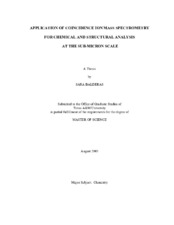| dc.contributor.advisor | Schweikert, Emile A. | |
| dc.creator | Balderas, Sara | |
| dc.date.accessioned | 2005-11-01T15:44:56Z | |
| dc.date.available | 2005-11-01T15:44:56Z | |
| dc.date.created | 2005-08 | |
| dc.date.issued | 2005-11-01 | |
| dc.identifier.uri | https://hdl.handle.net/1969.1/2530 | |
| dc.description.abstract | Surfaces can be probed with a variant of secondary ion mass spectrometry
(SIMS) where the bombardment is with a sequence of single keV projectiles, each
resolved in time and space, coupled with the separate record of the secondary ions (SIs)
ejected from each projectile impact. The goal of this study was to demonstrate an
efficient mode of SIMS where one obtains valid analytical information with a minimum
of projectiles and hence a minimum of sample consumption. An inspection of the
ejected SIs from individual bombardment events will reveal ??super efficient?? collision
cascades i.e., events, where two or more secondary ions were emitted simultaneously. It
has been shown that these coincidental emissions can provide information about the
chemical composition of nano-domains.
Previous studies using coincidence counting mass spectrometry (CCMS)
indicated an enhancement of identifying correlations between SIs which share a common
origin. This variant of SIMS requires an individual projectile impact thus causing SI
emission from a surface area of ~5 nm in radius. Thus, in an event where two or moreSIs are ejected from a single projectile impact, they must originate from atoms and
molecules co-located within the same nano-domain.
Au nanorods covered by a 16-mercaptohexadecanoic acid (MHDA) monolayer
were analyzed using this methodology. A coincidence ion mass spectrum was obtained
for the MHDA monolayer covered Au nanorods which yielded a peak for a Au adduct.
Similar results were obtained for a sample with a MHDA monolayer on a Au coated Si
wafer.
A series of samples consisting of Cu aggregates and AuCu alloys were
investigated by SIMS to demonstrate that this technique is appropriate for characterizing
nanoparticles. The mass spectra of these samples indicated that Au200
4+ is an effective
projectile to investigate the surface of the target because it was able to penetrate through
the poly(vinylpyrrolidone) (PVP) stabilizer that coated the surface of these
nanoparticles. Coincidence mass spectra of the Cu aggregates yielded molecules colocated
within the same nano-domain.
Finally, this methodology was used to investigate surface structural effects on the
occurrence of ??super-efficient?? events. The results indicated that it is possible to
distinguish between two phases of ??-ZrP compounds although the stoichiometry remains
the same. | en |
| dc.format.extent | 1701889 bytes | en |
| dc.format.medium | electronic | en |
| dc.format.mimetype | application/pdf | |
| dc.language.iso | en_US | |
| dc.publisher | Texas A&M University | |
| dc.subject | Secondary Ion Mass Spectrometry | en |
| dc.title | Application of coincidence ion mass spectrometry for chemical and structural analysis at the sub-micron scale | en |
| dc.type | Book | en |
| dc.type | Thesis | en |
| thesis.degree.department | Chemistry | en |
| thesis.degree.discipline | Chemistry | en |
| thesis.degree.grantor | Texas A&M University | en |
| thesis.degree.name | Master of Science | en |
| thesis.degree.level | Masters | en |
| dc.contributor.committeeMember | James, W. Dennis | |
| dc.contributor.committeeMember | Vigh, Gyula | |
| dc.type.genre | Electronic Thesis | en |
| dc.type.material | text | en |
| dc.format.digitalOrigin | born digital | en |


